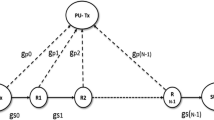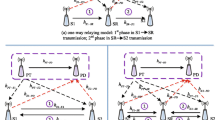Abstract
Cognitive radio is of great interest for current and future wireless communications. In this paper, the capacity of underlay cognitive radio networks is studied where closed-form expressions for both the ergodic capacity and the outage capacity of the secondary user (SU) are derived. The obtained results reveal new details on the joint effect of multipath fading and shadowing on the capacity of the SU where the increase of the ergodic capacity and degradation of the outage capacity due to heavy shadowing are demonstrated and quantified. Furthermore, the analytical results are verified by Monte-Carlo simulations for different fading scenarios.
Similar content being viewed by others
References
FCC.: Spectrum policy task force report. Report of Federal Communications Commission. Tech. Rep. 02-135 (2002)
Mitola, J.; Maguire, G.Q.: Cognitive radio: making software radios more personal. IEEE Trans. Inf. Theory 6(4), 13–18 (1999)
Goldsmith, A.; Jafar, S.A.; Maric, I.; Srinivasa, S.: Breaking spectrum gridlock with cognitive radios: an information theoretic perspective. Proc. IEEE 79(5), 894–914 (2009)
Gastpar, M.: On capacity under receive and spatial spectrum-sharing constraints. IEEE Trans. Inf. Theory 53(2), 471–487 (2007)
Ghasemi, A.; Sousa, E.S.: Fundamental limits of spectrum-sharing in fading environments. IEEE Trans. Wirel. Commun. 6(2), 649–658 (2007)
Kang, X.; Liang, Y.C.; Nallanathan, A.; Garg, H.K.; Zhang, R.: Optimal power allocation for fading channels in cognitive radio networks: ergodic capacity and outage capacity. IEEE Trans. Wirel. Commun. 8(2), 940–950 (2009)
Salhab, A.M.; Zummo, S.A.: Spectrum-sharing AF relay networks with switch-and-examine relaying and multiple primary users using orthogonal spectrums. Arab. J. Sci. Eng. 41(2), 513–525 (2016)
Fredj, K.B.; Aissa, S.; Musavian, L.: Ergodic and outage capacities of relaying channels in spectrum-sharing constrained systems. IET Commun. 7(2), 98–109 (2013)
Zhang, X.; Zhang, Y.; Yan, Z.; Xing, J.; Wang, W.: Performance analysis of cognitive relay networks over nakagami fading channels. IEEE J. Sel. Areas Commun. 33(5), 865–877 (2015)
Bithas, P.S.; Efthymoglou, G.P.; Kalivas, D.S.: Outage probability of cognitive relay networks over generalized fading channels with interference constraints. Proc. Comput. Sci. 40, 84–91 (2014)
Kamga, G.N.; Fredj, K.; Aïssa, S.: Multihop cognitive relaying over composite multipath/shadowing channels. IEEE Trans. Veh. Tech. 64(8), 3807–3812 (2015)
Miridakis, N.I.: On the ergodic capacity of underlay cognitive dual-hop af relayed systems under non-identical generalized-k fading channels. IEEE Commun. Lett. 19(11), 1965–1968 (2015)
Tran, H.; Duong, T.Q.; Zepernick, H.J.: Performance analysis of cognitive relay networks under power constraints of multiple primary users. In: Proceedings IEEE GLOBECOM, Houston, U.S.A, pp. 1–6 (2011).
Duong, T.Q.; Yeoh, P.L.; Bao, V.N.Q.; Elkashlan, M.; Yang, N.: Cognitive relay networks with multiple primary transceivers under spectrum sharing. IEEE Signal Process. Lett. 19(11), 741–744 (2012)
Hyadi, A.; Benjillali, M.; Alouini, M.S.; da Costa, D.: Performance analysis of underlay cognitive multihop regenerative relaying systems with multiple primary receivers. IEEE Trans. Commun. 12(12), 6418–6429 (2013)
Salhab, A.M.; Zummo, S.A.: Multiuser cognitive networks with nth-best user selection and imperfect channel estimation. Arab. J. Sci. Eng. 12(39), 8979–8987 (2014)
Simon, M.K.; Alouini, M.S.: Digital Communication over Fading Channels. Wiley, Hoboken (2005)
Al-Ahmadi, S.: The gamma-gamma signal fading model: a survey [wireless corner]. IEEE Antennas Propag. Mag. 56(5), 245–260 (2014)
Abdi, A.; Kaveh, M.: A comparative study of two shadow fading models in ultrawideband and other wireless systems. IEEE Trans. Wirel. Commun. 10(5), 1428–1434 (2011)
Al-Ahmadi, S.; Yanikomeroglu, H.: On the approximation of the generalized-k distribution by a gamma distribution for modeling composite fading channels. IEEE Trans. Wirel. Commun. 9(2), 706–713 (2010)
Gradshteyn, I.S.; Ryzhik, I.M.: Table of Integrals, Series and Products. Elsevier, Amsterdam (2007)
Goldsmith, A.; Varaiya, P.P.: Capacity of fading channels with channel side information. IEEE Trans. Inf. Theory 43(6), 1986–1992 (1997)
Brychkov, Y.A.; Marichev, O.; Prudnikov, A.: Integrals and Series, Vol 3: More Special Functions. Gordon and Breach Science Publishers, Philadelphia (1986)
Kostic, P.M.: Analytical approach to performance analysis for channel subject to shadowing and fading. IEE Proc. Commun. 152(6), 821–827 (2005)
Tse, D.; Viswanath, P.: Fundamentals of Wireless Communication. Cambridge University Press, Cambridge (2005)
Efthymoglou, G.P.: On the performance analysis of digital modulations in generalized-K fading channels. Wirel. Pers. Commun. 65(3), 643–651 (2012)
Papoulis, A.; Pillai, S.U.: Probability, Random Variables, and Stochastic Processes, 2nd edn. Tata McGraw-Hill Education, New York City (2002)
Author information
Authors and Affiliations
Corresponding author
Rights and permissions
About this article
Cite this article
Khoshafa, M.H., Al-Ahmadi, S. On the Capacity of Underlay Cognitive Radio Networks Over Shadowed Multipath Fading Channels. Arab J Sci Eng 42, 5191–5199 (2017). https://doi.org/10.1007/s13369-017-2688-7
Received:
Accepted:
Published:
Issue Date:
DOI: https://doi.org/10.1007/s13369-017-2688-7




